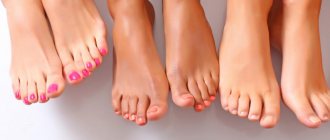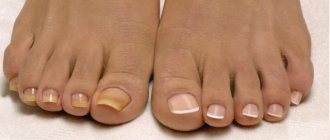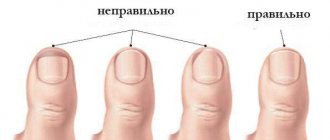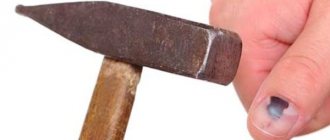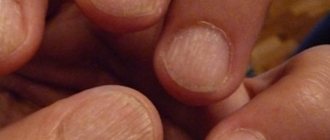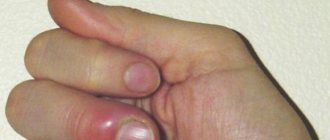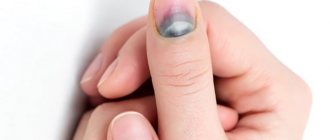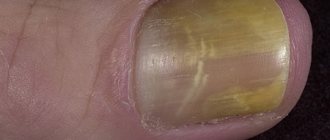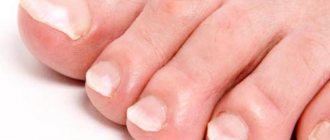How does paronychia manifest?
The process itself takes place on the palms, but due to the thickness of the skin, the liquid penetrates through the lymphatic openings to the areas surrounding the nail plate. Often paronychia provokes the occurrence of periungual panacirium - acute purulent inflammation of the tissues of the finger.
The nature of the course of this disease can be:
- Acute , in which it lasts less than one and a half months. The disease is bacterial in nature and is accompanied by severe pain and suppuration, mainly on the back of the fingers. Tissues located closer to the palm may also be affected - in this case, the inflammation spreads deeply, involving the hand.
- Chronic , with a duration of more than one and a half months. As a rule, this type of paronychia is caused by chemicals, dermatitis, psoriasis, eczema, and onychomycosis. In the chronic course of the disease (without the development of an abscess), the nail plate is affected: it becomes deformed, splits, becomes dull and yellow, crumbles, thickens (with fungal infection).
Use of medicinal plants
Medicinal plants - aloe, calendula, celandine - will help to successfully combat hand felon. They have long been used to treat many diseases, including purulent formations.
Every person probably has agave in their home, but not everyone knows and uses its healing properties. For treatment, you need to take a 3-year-old plant and select the fleshiest leaf. Cut a piece, remove the peel, apply the pulp to the sore spot and attach with a bandage. To speed up the anti-inflammatory effect of agave, the pulp must be slightly crushed until juice is formed.
Celandine is used to prepare a medicinal bath. Need 1 tsp. dry herbs, pour 500 ml of water, bring to a boil and keep on low heat for 10-15 minutes. As soon as the broth has cooled to a temperature of 70˚C, you can dip your sore finger into it and hold it for about 15 minutes. Exceeding the recommended temperature may result in burns. The bath should be done at least 2 times a day.
Calendula has a good anti-inflammatory effect. It is used in the form of an alcohol solution to be added to the bath. When steaming your finger, it penetrates perfectly deep into the skin and under the nail plate. It has a healing effect not only in cases of subcutaneous panaritium of the hands, but also in its subungual form.
Causes of the disease
Hands and nails are an area of increased risk of injury. The skin surrounding the nail plate is quite thin, so it is easy to damage. The inflammatory process that develops in tissues is the result of injury. Women suffer from paronychia much more often than men, and the main reason for this is manicure done with instruments that have not been sterilized. Infectious agents such as staphylococci, streptococci, and fungi penetrate into soft tissues.
Factors that can lead to inflammation:
- constant mechanical impact on the hands or feet, work at elevated temperatures;
- frequent contact with aggressive chemicals or cold water;
- hangnails (in children, the habit of biting their nails and the skin around them);
- injury during manicure or pedicure;
- nail extensions;
- poor hand skin care, which results in cracks;
- weak immunity;
- insufficient hygiene;
- inappropriate or low-quality shoes, as well as using someone else’s shoes;
- thrombosis, thrombophlebitis and other diseases in which blood circulation in the feet is disrupted;
- lack of vitamins, unhealthy diet;
- stress;
- diseases of the endocrine system, especially diabetes.
Surgery
Surgical intervention is carried out in cases where it was not possible to cope with panaritium using conservative treatment methods, that is, the patient’s condition worsened, body temperature increased, weakness appeared, signs of intoxication increased, and pus formed in the nail area.
The operation is mainly performed on an outpatient basis. Patients are hospitalized only when complications begin to develop and the condition rapidly worsens. In addition, people from risk groups, including those with diabetes, cardiovascular diseases, etc., are subject to inpatient treatment.
The extent of the operation depends on the location of the inflammatory process. If the panaritium was formed as a result of inaccurate nail treatment, around the hangnail, an excision of the edge of the nail plate is made. The central location of the inflammation will require opening the nail. After all, there is no other way to get to the source of inflammation. This method is the most difficult in terms of the development of complications; in some cases, deformation of the nail plate occurs as it grows. If pus has formed at the base of the nail, its root is removed.
The superficially located periungual panaritium is opened, while the nail plate is not affected. However, most often it breaks through on its own, and surgical intervention is not required. If the panaritium is localized deeply, the part of the nail involved in the infectious process is removed.
After the operation, the wound is not sutured, but must be drained. A bandage soaked in Betadine, Levomekolev or Gentamicin ointment is applied to the finger, which is changed daily. In some cases, “biological dressings” are used, which contain collagen and serum from donors.
For several days after the operation, you need to take care of not only your finger, but also your hand. It is necessary to provide her with maximum peace. To do this, a special plaster splint is placed on the finger, and the hand is immobilized.
If the patient’s condition is serious in the postoperative period, it is advisable to prescribe drugs to improve microcirculation, for example, Pentilin. In addition, immunostimulating agents (Methyluracil) are actively used.
Classification of paronychia and main symptoms
Characteristic forms
- Simple types of paronychia manifest themselves as an independent form of the disease, which is not a consequence of complications of other diseases. The skin around the nail turns red, swells, and minor pain appears. As a rule, with good immunity, the body copes with a simple form of paronychia in a few days; a visit to a doctor is not required.
- The purulent (pyococcal) form develops when microorganisms (staphylococci, streptococci) enter the tissues. The disease begins with the appearance of swelling and throbbing pain. After a couple of days, suppuration of the soft tissue occurs. Recovery begins after opening the abscess. Sometimes an abscess can spread to the hand; extremely rarely, it can spread throughout the body, affecting internal organs.
- Candidiasis is a form caused by fungi of the genus Candida. The nail fold loses the inner layer that protects the nail from damage. This form is chronic and is accompanied by minor inflammation. The purulent process is usually absent or not very pronounced. When fungi affect not only the skin, but also the nail plate, it begins to peel, crumble, thicken, and change shade. Most often, workers in the confectionery industry suffer from inflammation in the chronic stage.
- Ulcerative form - usually caused by pathogenic microorganisms or household chemicals, temperature exposure, injury, eczema or psoriasis. Ulcerative paronychia sometimes manifests itself as a complication of a simple form. Sores form on the skin around the nail, which can cause secondary infection.
- Horny form - occurs infrequently, mainly in patients with syphilis, characterized by the appearance of hyperkeratotic papules.
- The dry form is characterized by mild inflammation and the absence of suppuration. At the same time, the nail fold noticeably becomes coarser and flakes off.
- Tourniol is a form in which beta-hemolytic streptococci, staphylococci, and fungal microflora enter the tissue through wounds and burrs. Loose bubbles appear on the skin, the contents of which begin to fester. After opening the blisters, horseshoe-shaped wounds remain around the nail. Symptoms such as weakness and increased body temperature may appear. Tourniol is dangerous due to complete detachment of the nail and the development of lymphadenitis.
- Eczematous and psoriatic forms - the nail fold swells, becomes slightly inflamed, blisters appear, peeling, and the skin becomes thick. When the vesicles break open, crusts form. The nails acquire a lattice surface, longitudinal grooves, turn yellow, crumble and peel.
With the development of a purulent process, only the smallest ulcers open on their own. Therefore, to avoid an abscess, it is necessary to seek medical help as soon as possible.
Types of felon
Doctors distinguish several types of disease, each of which is characterized by a special localization of the inflammatory process:
- cutaneous – the upper layers are affected, treatment occurs quickly and much easier than with other forms;
- subcutaneous - pus is located in deep layers and requires careful treatment;
- subungual – the infection is located under the nail, which significantly complicates treatment;
- periungual – microorganisms are localized in the area of the nail fold;
- articular - the infection penetrates so deeply that it affects cartilage tissue;
- bone - a severe form of the disease affecting the bone next to the phalanx, where the inflammation is localized;
- osteoarticular – the result of the development of the articular form of the lesion, the interphalangeal space is drawn into the process;
- tendinous - one of the most severe forms, in which the ligamentous apparatus is involved.
Photo of felon on a toe. Types of skin lesions can be combined and flow into each other. Lack of treatment leads to relapses and worsening symptoms.
Symptoms
Typically, the signs of paronychia are quite pronounced, which allows you to make a diagnosis quickly and accurately. They are expressed as follows:
- the patient complains of pain in the area of the nail plate; the nature of the pain can be different: throbbing, constant, pulling;
- swelling of the nail fold occurs and can spread to the entire upper part of the finger;
- due to swelling and pain, it is difficult to bend your fingers and work with your hands; if parochinia has developed on the foot, it hurts to put on shoes;
- damaged skin becomes red, burgundy, dark purple, and if there is suppuration, then yellow-green;
- if the process affects several fingers, body temperature often rises and pain appears.
The doctor determines the presence of the disease and determines the cause of the pathology: it may be associated with professional activity or with exposure to pathogenic microorganisms. In the second case, a microbiological test is prescribed to determine which pathogen caused the disease.
To confirm the inflammation process, the patient undergoes a general blood and urine test.
Based on the type of pathogen, paronychia is divided into:
- bacterial: in acute cases the culprit is Staphylococcus aureus, and in chronic cases – streptococci and pseudomonads;
- viral, the causative agent of which is the herpes simplex virus;
- fungal, in which infection occurs with fungi of the genus Candida;
- non-infectious, developing from exposure to adverse and irritating environmental factors, as well as as a side effect from taking certain medications; may be associated with skin diseases.
The “leaders” are bacterial and fungal forms of paronychia.
Pathogenesis and symptoms
Unpleasant conditions are caused by pathogens that have gotten under the nail or into soft tissues: most often these are staphylococci or fungi. Recent data indicate that the herpes virus can infect both fingernails and toenails.
Development and types of abscesses
It all starts with slight redness of the periungual area and the formation of edema. Then the pain syndrome is activated, and a bubble with an infiltrate containing pathogenic microorganisms is formed. As a result of the vital activity of pathogens, the contents are converted into purulent exudate. There are two types of pathological process:
- paronychia - a finger on the hand becomes inflamed near the nail with redness and swelling, a purulent infiltrate forms along the nail fold;
- panaritium - inflammation spreads to other areas of the finger, suppuration progresses.
Paronychia can be acute or chronic. Acute development is typical in the case of a bacterial infection. Here the pain syndrome is pronounced, the symptoms rapidly increase with the formation of a purulent papule near the base of the periungual fold. Chronic pathology is less common and is considered a sign of the presence of systemic diseases. In this case, inflammation on the finger near the nail begins with hyperemia of the area. Slight swelling and mild pain appear after 1-2 days. Panaritium is a complication of advanced paronychia or the result of improper treatment of an abscess.
Subtypes of felon flow
Skin inflammation . Formed on the “pad” of the finger, pus sometimes mixed with blood accumulates under the epidermis. There is itching and slight redness, the pain is insignificant. If the purulent papule increases, this indicates the spread of the process to the surrounding tissues.
Nail felon . Pus accumulates near the fingernail or toenail, then moves under the plate. The cause of trouble can be a splinter, punctures with sharp objects, or the ingress of solid particles of debris.
Bone pathology . The infection enters directly into the bone of the finger as a result of a fracture, spreading to the bone tissue with the progression of paronychia.
Panaritium of the interphalangeal joints . A dangerous condition is manifested by a sharp decrease or complete loss of mobility of the affected joint and phalanx of the finger, severe swelling and pain. This condition is provoked by chronic arthrosis and arthritis, penetration of pathogens into the joints of the fingers during suppuration of the finger at the nail , with advanced paronychia.
Tendon inflammation (tenosynovitis) . In this case, the mobility of not only the affected finger, but also the entire hand is limited. The disease is accompanied by severe pain and general malaise.
Treatment options
The initial stage of the disease can be treated conservatively. If slight redness and mild swelling occur, you can use home methods. If a purulent process is noticeable, emergency assistance from a specialist - a podologist, surgeon, or dermatologist - will be required. For any inflammation accompanied by the accumulation of pus, surgical intervention is necessary.
During the treatment process, you need to remember the following rules:
- When doing housework and any other work, hands must remain dry, all actions are carried out wearing protective gloves;
- if the cause of the disease is chemicals, you need to temporarily stop or at least limit contact with them;
- if parochinia is localized on the feet, you should wear only comfortable, spacious shoes of good quality.
Treatment of purulent form
If an abscess is present, the abscess is opened surgically. If this is not done, the patient's condition will inevitably worsen. This operation is performed with or without local anesthesia. In the first case, small incisions are made on the skin, in the second, punctures are made with a needle. Immediately after opening the abscess, a bandage with ointment is applied, the pain stops, and the patient feels relief. Ointments must be effective against Staphylococcus aureus. Drainage is almost always installed to speed up the separation of pus. In more serious cases, where the abscess has spread to the nail bed or there is an ingrown nail, partial removal of the nail may be necessary. Oral antibiotics are also prescribed, especially if the immune system is weak.
If the cause of parochinia is a fungus, antifungal drugs are used, for example, clotrimazole. Sometimes the doctor prescribes antifungal medications for internal use, such as fluconazole.
Parochinia, which has developed against the background of eczema, psoriasis or syphilis, requires specific treatment methods. Conventional therapeutic measures are supplemented by physiotherapeutic procedures (corticosteroids, ultraviolet irradiation).
After the operation and installation of drainage, the patient should come back for a follow-up appointment some time later to assess the condition. Usually, with adequate care and compliance with all medical recommendations, paronychia is completely cured and has no relapses. The patient is recommended to take multivitamin complexes to strengthen the body's protective reserves.
Treatment of paronychia with home methods
You can engage in independent treatment only if there is no purulent inflammation. Under no circumstances should children be treated at home!
If there is definitely no abscess, then baths with antiseptics (chlorhexidine, povidone-iodine), which are done several times a day for 15 minutes, will help.
Herbs such as calendula and chamomile also have antiseptic properties. Decoctions of them can also be used in the form of baths.
A good effect is obtained by using a solution of sea salt, as well as soda and potassium permanganate for baths.
The listed solutions can also be used for compresses.
Principles of disease therapy
Treatment of felon on the leg at home is necessary according to certain rules:
- without contacting a doctor, therapy is possible only in the initial stages, when the pain is insignificant, and swelling and swelling are almost absent;
- when the disorder is combined with immunodeficiency or diabetes mellitus, even the initial forms of the disease must be treated together with a doctor;
- therapy without surgery is possible only for the skin form of the disease, as well as in the presence of only a small lump with serous pus;
- Surgery is indicated when conservative treatment applied for 2-3 days is ineffective, as well as when profuse purulent discharge of yellow and green color forms.
For mild forms of subcutaneous and cutaneous panaritium on the toe, treatment is possible using traditional and conservative methods, but other pathologies require a more careful approach.
Therapy for subungual disease
The only effective way is to perform a quick operation . Folk remedies and medications, including antibiotics, are ineffective for this form of the disease.
Treatment of tendon pathology
Like the previous form, treatment can only be done after consulting a doctor. At home, using traditional methods, you will not be able to get rid of the disease. In the first 3 days, medications are prescribed; if they are ineffective, they proceed to surgery.
Prevention of paronychia
Prevention:
- keep your hands and feet clean and dry at all times;
- get rid of the bad habit of biting your nails and surrounding skin;
- After washing your hands, apply cream to the skin;
- When contacting aggressive chemicals, be sure to use gloves;
- do not cut the cuticle, especially on the toes;
- do not bite off hangnails;
- disinfect manicure and pedicure tools;
- trim toenails correctly to prevent ingrown nails;
- fight sweaty feet;
- monitor blood glucose levels;
- wear comfortable, high-quality and dry shoes.
If infection does occur, paronychia begins to develop, without wasting time, seek medical help. This will allow you to cure the disease painlessly, in a short time and without the risk of complications.
Causes of panaritium
Pathological factors can be divided into 2 groups: primary and secondary. Primary infections include direct infection as a result of infection with staphylococcus and other pathogenic flora. These microorganisms easily multiply in all layers of tissue of the human body - skin, joints, tendons, bones.
Important! Infection is provoked by factors such as punctures and cuts, and ingrown nails.
The secondary group of causes includes chronic diseases and disorders that reduce immunity and create a favorable environment for the proliferation of bacteria:
- hormonal imbalances;
- varicose veins and other vascular diseases of the legs;
- acute allergic reactions that attack the immune system for a long time;
- diabetes;
- hypothermia;
- unfavorable conditions - high humidity in shoes (artificial materials or staying in closed shoes in extreme heat).
Be sure to read:
How to get rid of spider veins on your legs
This group also includes non-compliance with daily hygiene - the maximum concentration of bacteria accumulates on dirty feet.
Improper pedicure and the use of household chemicals that come into contact with the skin of the feet are common causes of panaritium on the big toe.
Features of treatment
If it is not possible to get an appointment with a specialist in a short time, then you should carry out some manipulations, namely:
- Warm bath with a weak solution of potassium permanganate or baking soda. The duration of this procedure should be 10 minutes. It can be repeated after 2 hours.
- To draw out the pus near the nail from the abscess, you need to apply the pulp of Kalanchoe or aloe to it. This will not only remove some of the purulent contents, but also reduce the pain of the affected area.
Despite these measures, you still need to see a doctor. The specialist will open the nail abscess and remove the accumulated purulent exudate. Further treatment should consist of treating the wound surface with disinfectants and applying a bandage. In some cases, after opening the abscess, the doctor also removes the nail plate.
After surgery, the doctor prescribes medications to treat the abscess site, as well as antibiotic drugs to suppress possible infection.
Drug therapy
Before using any medication, you should consult your doctor. It is worth strictly following his recommendations, as well as studying the instructions for use of a particular drug. It is important to adhere to the course of treatment, especially for oral antibiotics. You should not stop taking it if the symptoms go away; it is important to complete the course completely so that the infection does not spread.
Effective traditional medicine recipes
Before using any home remedy, you should consult your doctor. The specialist will tell you whether it is possible to use the prescription if your toe is suppurating and swollen. Among the most effective folk methods are:
- Applying a baked onion to the wound, applying a sterile pressure bandage over it.
- Aloe pulp compress. Such a compress helps the release of pus, and also soothes the affected tissues and accelerates regenerative processes.
- Compress from a clean sheet of coltsfoot. It is applied for 12 hours.
To achieve maximum effectiveness in treating abscesses of the big toe or other fingers, it is recommended to alternate the use of compresses and antiseptic and anti-inflammatory ointments or creams. It is not such a great job to prepare a compress, but its effectiveness is clearly noticeable.
If an abscess has formed on a child’s finger near the nail, treatment must be approached with particular caution. You must strictly adhere to all the doctor’s recommendations, who will tell you what to do in this situation and how to treat this condition in children.
